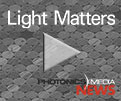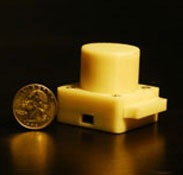 
 |
Pharmacy Regulations Stalling Uptake of Optical Spectroscopy
Optical spectroscopy has long been a crucial tool for drug development as well as drug inspection and testing, and the past decade has seen a testing trend emerge: Ever-more-stringent regulatory controls have meant that some drug companies are slow to adopt, or invest in, new methods and instrumentation. The dilemma is that most of today’s products are not fully tested until they are in finished product form – often in their packaging – so adopting the latest cutting-edge optical spectroscopy technique can be imperative. |
|
|
|

Optical Time-Stretch Brings Diagnostics to a New Timescale
A new platform delivers the best of both worlds – throughput and accuracy – for biomedical and life sciences applications. Optical technology arguably has been playing a decisive role in advancing modern biomedicine. Enabling high detection sensitivity and/or high imaging resolution, optical microscopy and spectroscopy have been the gold standard adopted in all life sciences and clinical laboratories for shedding light on undeciphered biological processes. |
|
|
|

Two Modalities Are Better Than One
Multimodal imaging systems advance breast imaging and other applications. The most widely used technology for early detection of breast cancer – x-ray mammography – still suffers several major limitations. It misses roughly 20 percent of breast cancers, for example, and its performance is even worse in younger women with higher-density breast tissue. Also, the technique exhibits a high false positive rate, with 70 to 80 percent of breast biopsies coming back negative. This can add considerably to patients’ financial and mental stress. Optical imaging can help to address these limitations. |
|
|
|

 |
sponsored by
 |
In this edition of the industry's premier weekly newscast: Glasses-free 3-D goes mobile, a metamaterial obtains the strongest signal yet of photonic spin Hall effect, a new theory suggests an unconventional use for EMCCD, tests reveal the hazards of ordinary laser pointers, tailored photons are generated from solid-state chips, and photoacoustic microscopy receives a federal grant. Hosted by Photonics Media's Melinda Rose and Laura Marshall. |
|
|

Laser-Based Process Rapidly Fabricates Implants
A new method will advance stereolithography from the rapid prototyping arena to the actual production of 3-D biodegradable scaffolds, and will enable efficient translation of this technology to clinical applications. Biomaterials science encompasses elements of medicine, biology, physics, chemistry, tissue engineering and materials science. Tissue engineering has been a rapidly expanding interdisciplinary field, with the goal of growing tissues or organs directly on controlled 3-D environments called scaffolds, which are microenvironments analogous to the natural ones. |
|
|
|

Anisotropy Imaging Elucidates Dynamic Molecular Interactions
Fluorescence anisotropy is a well-known technique in fluorescence spectroscopy and biochemical assays and has been used in epifluorescence microscopy in living cells and even in superresolution imaging. But when used on live-cell specimens in point-scanning confocal instruments, fluorescence anisotropy has shown the unfortunate effects of photobleaching, low frame rates and temporal skew resulting from sequential point scanning. |
|
|
|

PROMOTION

 |
Join Us for a Free Webinar
2013 Webinar Series - Expert Briefings
Computational Microscopy, Sensing and Diagnostics for Telemedicine and Global Health Applications
Wednesday, June 5, 2013 – 1 p.m. EDT/10 a.m. PDT
 Photonics Media will host Dr. Aydogan Ozcan, Associate Professor, Bio- and Nano-Photonics Laboratory, Electrical Engineering and Bioengineering Departments, UCLA. Dr. Ozcan will introduce new imaging and detection architectures that compensate digitally for the lack of complex optical components available in cell phones by using novel theories and algorithms to address the immediate needs of telemedicine for global health problems. Photonics Media will host Dr. Aydogan Ozcan, Associate Professor, Bio- and Nano-Photonics Laboratory, Electrical Engineering and Bioengineering Departments, UCLA. Dr. Ozcan will introduce new imaging and detection architectures that compensate digitally for the lack of complex optical components available in cell phones by using novel theories and algorithms to address the immediate needs of telemedicine for global health problems.
|
|
|

Ultrasonic Invisible Scalpel Performs Noninvasive Surgery
There’s more to ultrasound machines than simply watching babies develop inside the womb. They’re used to blast apart kidney stones and prostate tumors, for example. And now, with a nanotube-coated lens, the technology could be honed to create an invisible sonic blade for noninvasive – perhaps even painless – microsurgery. |
|
|
|

Nanoprobes Beam Brightly on Biomarkers
Step aside, surface-enhanced Raman scattering probes. There’s a new nanoprobe in town, and it can shine 20 times brighter than a conventional probe when swept with an infrared laser. The discovery could lead to better-targeted drug delivery and deeper bioimaging within tissue. |
|
|
|

Laser Microscopy Tests for Skin Damage
Beauty is only skin deep, and now scientists can use a laser microscopy technique to gauge a person’s true age from his/her most shallow layer – the skin. The method could provide a standardized way to measure the extent of skin damage and the effectiveness of anti-aging skin products. |
|
|
|




The Digital Holography and Three-Dimensional Imaging (DH) topical meeting provides a forum for science, technology, and applications of digital holographic and three-dimensional imaging and display methods. Topic areas include, for example, holographic interferometry, phase microscopy, novel holographic processes, 3-D displays, integral imaging, computer generated holograms, compressive holography, holography with incoherent sources, and full-field tomography, as well as special techniques for optical trapping, cellular microscopy, aberration compensation, and super-resolution.
MORE INFO >> |
|
 |
 |


Follow Photonics Media on Facebook and Twitter
|
   |
|

sponsor
 |

sponsor
 |

sponsor
 |


sponsor
 |
 
sponsor
 |

|